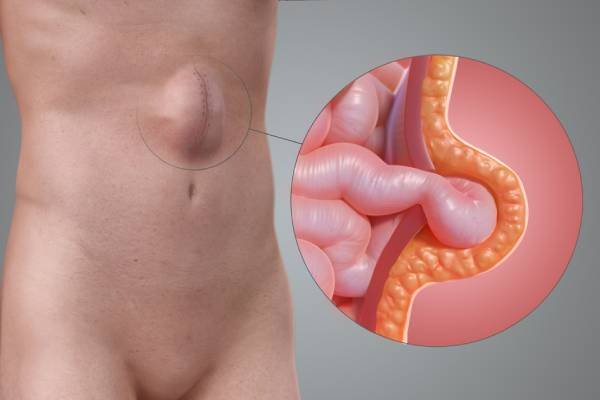Incisional Hernia
An Incisional hernia is a hernia that occurs through a previously made incision in the abdominal wall that is scar left from a previous surgical operation.

𝗖𝗮𝘂𝘀𝗲𝘀 𝗼𝗳 𝗜𝗻𝗰𝗶𝘀𝗶𝗼𝗻𝗮𝗹 𝗵𝗲𝗿𝗻𝗶𝗮
- Becoming pregnant before the cut fully heals.
- Putting too much pressure on your abdomen.
- Getting back into physical activities too soon after surgery.
𝗦𝘆𝗺𝗽𝘁𝗼𝗺𝘀 𝗼𝗳 𝗜𝗻𝗰𝗶𝘀𝗶𝗼𝗻𝗮𝗹 𝗵𝗲𝗿𝗻𝗶𝗮
- A visible bulge in the abdominal wall.
- Pain, pressure, aching or burning at the hernia site.
- Redness in the area.
- Symptoms of intestinal obstruction, including bloating, nausea, vomiting and abdominal pain.
𝗣𝗿𝗲𝘃𝗲𝗻𝘁𝗶𝗼𝗻 𝗼𝗳 𝗜𝗻𝗰𝗶𝘀𝗶𝗼𝗻𝗮𝗹 𝗵𝗲𝗿𝗻𝗶𝗮
- Maintaining a healthy weight can reduce the risk of a hernia caused by being overweight.
- Exercise regularly and lift heavy weights can reduce strain on the abdomen.
- Treating chronic constipation and chronic cough can prevent strain on the abdominal wall.
- Avoid smoking, as this can cause slower wound healing.
- Manage any existing medical conditions, such as diabetes to support wound healing.
𝗥𝗶𝘀𝗸 𝗙𝗮𝗰𝘁𝗼𝗿𝘀 𝗼𝗳 𝗜𝗻𝗰𝗶𝘀𝗶𝗼𝗻𝗮𝗹 𝗛𝗲𝗿𝗻𝗶𝗮
- Wound infection.
- Jaundice.
- Obesity.
- Malnutrition.
- Smoking.
- Older age.
- a large scar across the middle of the abdomen.
𝗪𝗵𝗲𝗻 𝘁𝗼 𝘀𝗲𝗲 𝗮 𝗱𝗼𝗰𝘁𝗼𝗿
If you notice that the bulge has turned dark red or purple or you feel severe pain, nausea, vomiting, fever or rapid heart rate.
𝗪𝗵𝗮𝘁 𝘄𝗲 𝗱𝗼?
𝗢𝗽𝗲𝗻 𝗵𝗲𝗿𝗻𝗶𝗮 𝗿𝗲𝗽𝗮𝗶𝗿:- Open hernia repair is often performed under local anesthesia or regional anesthesia injected into the spine.
𝗟𝗮𝗽𝗮𝗿𝗼𝘀𝗰𝗼𝗽𝘆 𝗦𝘂𝗿𝗴𝗲𝗿𝘆:- A laparoscopy is a keyhole surgery performed on the abdomen. A small incision is made in the abdomen. A thin tube is inserted to look inside the abdomen and pelvis. This thin tube contains a light and a camera called a laparoscope.
